.
The first year I cultivated my garden, I decided to sow a few calendula between rows of red cabbage. The patch looked beautiful with its combination of thick violet cabbage heads and the bright orange calendula flowers floating above them like tiny suns. Not knowing how to use the flowers, I just let them wither and harvested only the cabbage. I don’t know what I had decided to plant on that patch the following year. What I do know, however, is that the only thing that grew there was calendula. They spread like the proverbial wildfire and it was time to get them under control (failed!) and learn how to use them (check!). This post shows you my five favourite uses for calendula.
Ingredients and benefits of calendula
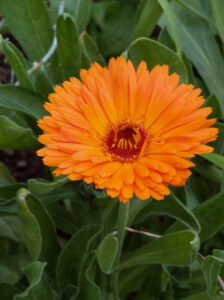
Calendula is often used against skin problems like small wounds, burns, cracks, bruises and inflammation. Folk medicine also uses it for stomach and bowel disorders, emotional stress and injuries. Calendula contains flavonoids, triterpenes and saponines. Fat-soluble faradioles are mainly responsible for the wound-healing effects.
Among others, calendula shows antibacterial, decongestant, anti-inflammatory and anti-fungal as well as antispasmodic effects. Furthermore, it supports the formation of new connective tissue.
With its brightly warm and sunny orange nature, calendula heals not only physical wounds but is also said to have a soothing effect on an emotional level.
All recommendations in this post are based on my experience. I’m not a doctor and thus cannot be held liable for any adverse effects in connection with the use of the following recipes.
Five uses for calendula
#1 Calendula oil
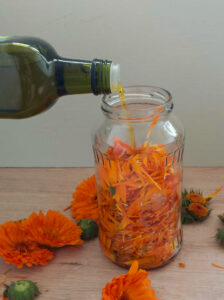
This is a classic and so easily made. All you need is
1 glass jar with lid
Calendula flowers (fresh or dry)
Olive oil
Pluck the petals from the calendula flowers and fill them loosely into the glass jar until it’s roughly full. Fill the jar up with the olive oil and close the lid. Put the jar onto a windowsill and let it rest for 10 – 14 days. Shake it every day.
After that time, strain the oil through a sieve into a second jar. Press the petals out thoroughly to remove every drop of oil. Close the jar and store the oil in a cool, dark and dry place for up to one year.
If you’re pressed for time, you can make a warm extraction. For that purpose, put the calendula petals and the oil in a jar and place that you place in a hot water bath. Let it simmer for about 30 minutes at no more than 60 °C while occasionally stirring. Let it cool and repeat the process. Then filter the mixture through a sieve and let it cool down.
Application
Calendula oil can be used as an alternative to calendula salve (see below) to support wound healing. It’s great for small injuries, inflamed skin, mastitis or nailbed infections. You can make compresses with gauze presses soaked with calendula oil. However, you should never apply it on deep or open wounds. Calendula oil is also an ingredient for calendula salve and calendula soap.
#2 Calendula salve
As I said before, calendula is THE herb for the skin. It soothes your skin and heals small wounds and irritations. Number 2 of my favourite uses for calendula is calendula salve. You’ll only need
250 ml calendula oil
25 g beeswax
Slightly warm the oil in a pot. Add the beeswax and let it melt until all is liquid. Make sure that the oil temperature won’t rise above 60 °C. Fill the mixture into small jars, close the lid tightly and let it cool. Store at a cool and dry place for up to one year.
Application
Use calendula salve as a soothing hand cream for working hands or to support the healing of irritations or small wounds. If you work in the garden and are a bit like me, you’ll always have scratches, skin irritations (hello stinging nettles) and overall rough hands. This is when calendula salve can do wonders for your skin. It soothes immediately and minor injuries seem to heal almost overnight!
#3 Calendula tincture
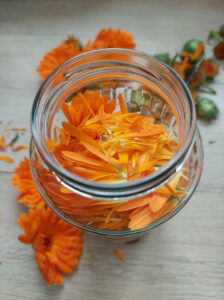
A tincture is a herbal extract in alcohol. For this calendula tincture, we need:
1 glass jar with lid
Calendula flowers (fresh or dried)
Alcohol (45 %)
Pluck the petals from the calendula flowers and fill them loosely into the glass jar until it’s roughly full. Fill the jar with alcohol (45 %) and close the lid. Put the jar in a warm place at room temperature but without direct sunlight and let it rest for 7 days. Shake it every day.
Strain the tincture through a sieve and press the petals out thoroughly. Fill the tincture into dark jars (e.g. amber glasses) and store at a cool, dark and dry place for up to one year.
Application
Like calendula oil and salve, you can use calendula tincture to support wound healing or prevent inflammation. However, tincture must be diluted. Add 1 – 2 tablespoons of calendula tincture to 1/4 l of distilled or boiled water. Soak a gauze pad in it and fix it with a dressing on the wound in question. Large, open wounds should be shown to a doctor.
Furthermore, calendula tincture may be used as a mouthwash in case of gum inflammation or other inflammation in the mouth. Add 1 tablespoon of calendula tincture to a glass of warm water and rinse your mouth with it.
#4 Calendula tea
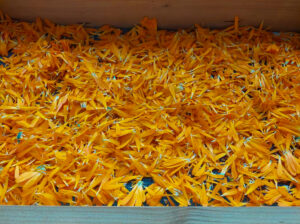
This is the easiest way to preserve calendula flowers. You just pluck the petals off and let them dry. This is best carried out in a dry place (who would’ve thought it) without direct sunlight but enough air circulation.
When the petals are dry, store them in a glass jar or tea box.
To make calendula tea, put 1 – 2 teaspoons of dried calendula petals into a cup and pour hot water over them. Let it sit for 10 minutes before use.
Application
Calendula is often added to tea blends against stomach and bowel disorders or menstruation problems.
I often add a teaspoon of dried calendula to our morning tea blend. Apart from soothing the belly it always – at least in my opinion – adds a ray of sunlight to the day.
Calendula tea can also be used for washing out wounds or as a wound compress. Soak a gauze pad with calendula tea, put it onto a wound or irritation and fix it with a dressing. It can also be used as a wound pad for eyes, bruises, varicose veins or haemorrhoids. Breastfeeding mothers can use calendula compresses to soothe their irritated breasts. And, last but not least, you can rinse your mouth with calendula tea whenever you have an inflammation in the mouth or throat area.
#5 Calendula soap
This is a bit more complex to make and you should know about the basic processes of soapmaking. If you do make the effort, however, you’ll create a very mild soap that’s even suitable for baby’s skin care.
For this easy beginner’s soap, you’ll need
700 g calendula oil (see above)
200 g coconut oil
100 g sunflower oil
133 g sodium hydroxide
330 g calendula tea
1 tbsp dried calendula petals
For the detailed process of making this soap check out this blog post on calendula soap.
Calendula soap always reminds us of how wonderful summer is – even when it’s dark and cold outside. The special thing here is that we use calendula not only as a soap additive but also as a colouring agent. The calendula tea as the basis for the sodium hydroxide makes a beautiful yellow colouring of the soap. That way, we won’t have to use colouring additives like clays or soap pigments.
Calendula is a wonderful plant for body and soul and I hope I’ve inspired you to try out some of the easy recipes above to preserve it.

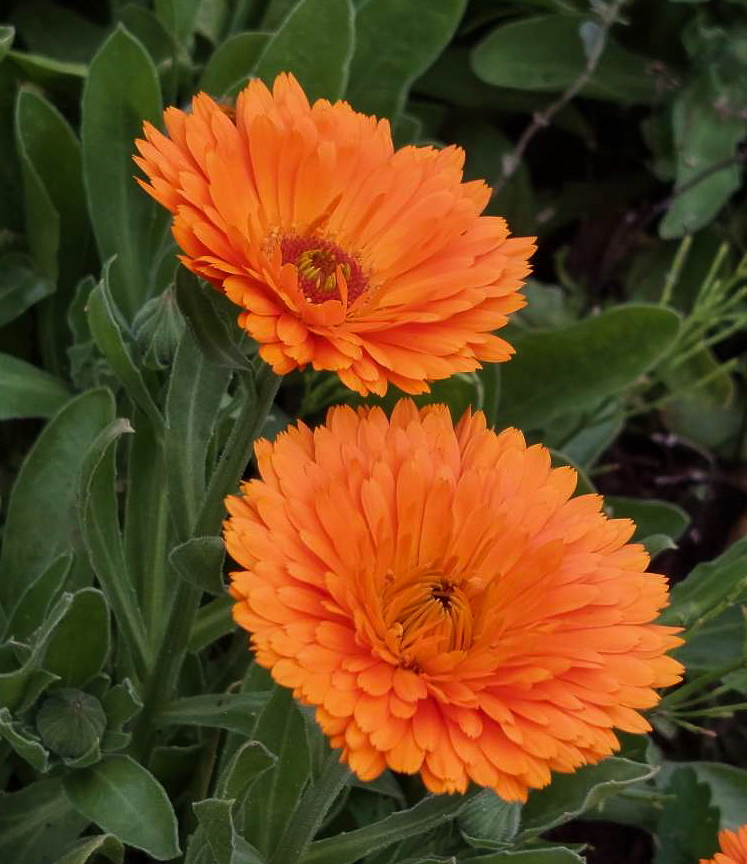
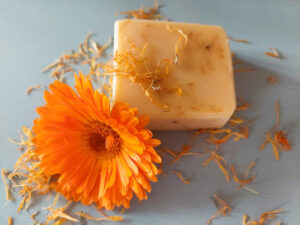
0 Comments